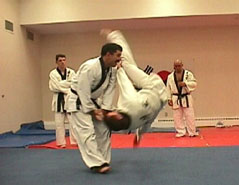Philosophy
of Hapkido
 If
we agree that the true philosophy of a martial art must be based
on and logical connection to its techniques, we can naturally
admit that the philosophy of Hapkido shares most essential part
with Taekwondo philosophy. And additionally, as Hapkido is also
a traditional martial art of Korea as well as Taekwondo, we
have technical and historical basis for research of their sameness;
the ways of Samjae and Kang-Yu. If
we agree that the true philosophy of a martial art must be based
on and logical connection to its techniques, we can naturally
admit that the philosophy of Hapkido shares most essential part
with Taekwondo philosophy. And additionally, as Hapkido is also
a traditional martial art of Korea as well as Taekwondo, we
have technical and historical basis for research of their sameness;
the ways of Samjae and Kang-Yu.
But we'd better to observe their difference first. Let me review
several explanations about it.
| |
"HAPKIDO
is a Korean Martial Art. This style is pronounced HOP
- KEY - DOE - the Way (DO) to bring one's Power (KI) into
Flowing Motion (HAP)."(From JUDE'S
HAPKIDO PAGE)
"The techniques of
Hapkido are themselves based on three underlying principles:(1)The
Water Principle, (2)The Principle of Circular Motion,
(3)The Harmony Principle"(From European
Hapkido Alliance)
"There are three
basic skills to be learned: (1)Non-resistance. Meet forces
with minimum force to deflect and not clash with an adversary's
power. (2)Circular motion, countering and attacking.
(3)The "Water Principle." Total penetration
of an enemy's defenses." (From Lok's
Hapkido Study) |
Summing up them above, the principles of Hapkido can be explainend
like this: its main principle can be said to be that of Hapki(Collection
of inner power) and it is to be performed through three ways;
water, circular motion and harmony or non-resistance. This scheme
is all that was suggested so far.
But philosophy is not scheme; it should be a systematical consideration
of all parts of martial art. Additionally the principles are
suggested too simply way, so they became dogmas. They need some
comments. You can find them in PPT and 3JKY.
The principle of water is explained in Ch.23
of Taekwondo Principle.
The principle of non-resistance is that of Yu, explained in
Ch.7-4 of 3JKY.
The principle of harmony is explained in Div.1
of Taekwondo Principle.
The principle of circular motion is explain in Ch.6-10-1
of 3JKY with more specification of another kinds of figures
that must be in motions. And it seems obvious that the motions
of Hapkido, though they use circular motions, include non-circular
motions too. The non-circular motions can be understood as foundation
that enables the circular motions to be offense and defence.
And I'd like to point out that harmony is broader concept than
non-resistance, so that they cannot be replaced or compared
in the same level. Non-resistance is more concrete principle
that can be applied to a technique while harmony is rather a
sort of ideology. It is quite obscure to apply it to technique.
The philosophy of Taekwondo tells us the difference.
In conclusion, Hapkido is another name of TAEKWONDO in its
essential part. Thus, the philosophy of Hapkido is almost same
as that of Taekwondo. In order to find some uniqueness of Hapkido,
we can say that Hapkido is more soft and skillful system of
offense and defense than Taekwondo. In that sense, Hapkido can
be said to be more elegant than Taekwondo. Instead, it can be
said its basis is TAEKWONDO.
|